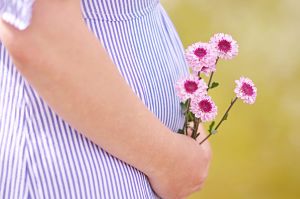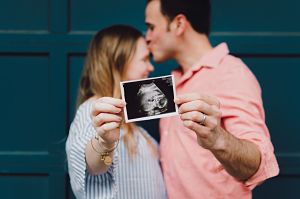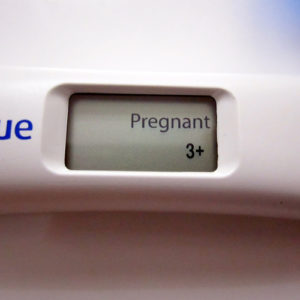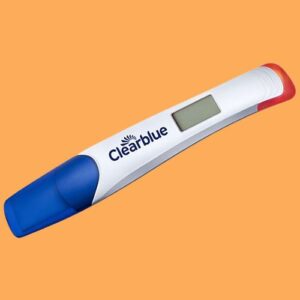The Zoom Baby Ovulation Test FAQ aims to answer some of the questions you may have about ovulation testing. For those new to the process, ovulation testing can seem daunting at first but it is actually fairly straightforward. Once you know what you are doing, predicting ovulation becomes a breeze! 🙂
What Does an Ovulation Predictor Kit (OPK) Tell Me?
Luteinising hormone is something that is found in a woman’s urine almost all of the time. However, just before ovulation (normally about 12-36 hours before), the amount of LH present in a woman’s urine increases significantly. This is known as the “LH Surge”. An Ovulation Predictor Kit (OPK) detects luteinising hormone in your urine and gives you a positive result when the LH reaches a certain level.
Ovulation Predictor Kits (OPKs) are very handy if you are trying for a baby as they give you advanced warning as to when your body is about to release an egg, so you can plan to have sex at the right time! OPKs can be used with basal temperature and cervical mucus to help determine periods of fertility and infertility.
Further reading: What is Ovulation?
How Do I Read the Results of an Ovulation Predictor Kit (OPK)?
When using an Ovulation Predictor Kit, you will be looking for two lines — a “control” line and a “test” line. For a positive result, the test line must be as dark as, or darker than, the control line. (This will indicate that the level of LH in your urine is now much higher than the ordinary amount of LH usually found in your urine every day)
Sometimes interpreting the results of your test can be difficult. For some women it may seem as if the second line never reaches the stage of being darker than the control. You may see two lines, but the test line wasn’t darker than the control line, so technically it’s a negative. However, drinking a lot of fluids and urinating within 4 hours of testing will definitely have an effect on the concentration of your urine and can lead to false negatives.
Don’t worry, you may find it takes a “practice” cycle or two to learn what a positive test looks like for you.
If you’re charting your basal temperature and/or cervical mucus, Ovulation Predictor Kits can help you identify the approximate time of ovulation.
What Is the Best Time of Day to Take the Ovulation Test?
Such a common question, we have written a whole article on the best time of day to take an ovulation test. Generally, you should test between 1pm-5pm. Testing too early in the day may give you a false negative. If you test too late in the evening, you may miss your surge. Test at the same time every day. Don’t urinate for 4 hours before testing. Reduce fluid intake for 4 hours before testing.

Can an Ovulation Predictor Kit (OPK) Be Positive for More Than One Day?
Levels of LH surge about 12-36 hours before ovulation takes place, before going back to normal. In theory, this means that you could detect this high level of LH from the very beginning to the very end — a period of over 36 hours!
If you have a positive OPK for more than 3 consecutive days, your ovary may just be having trouble releasing the egg. This can happen for many reasons (stress, illness etc). If this happens to you every now and then, it’s not a major problem. If it seems to happen a lot, talk to your GP.
Should I Keep Testing Once I Get a Positive Ovulation Predictor Kit (OPK)?
Once you get a positive you will probably ovulate within the next 12-36 hours. There’s now no need to take another test. If you are monitoring other indicators, they may also confirm that you are about to ovulate — cervical mucus may dry up, BBT may rise. If you don’t see these other indicators you may want to take another OPK test.
If you have multiple positive OPK Tests in one month, you might want to talk to your doctor. Polycystic Ovarian Syndrome may cause a woman to have positive OPKs due to high levels of LH all cycle long, with no ovulation. Your GP will be able to test for this and offer treatment options.
When Should I Start Using the Ovulation Predictor Kits (OPKs)?
If you’ve been taking and charting BBT, you may already know approximately when you ovulate each month. Start using your tests a few days before you think you may ovulate.
If you do not track BBT, but have a 28 day cycle, start your OPKs on day 10. For every additional day of your cycle add one day to when you should begin testing. If you go an entire month with no surge detected, try using the Ovulation Predictor Kits a couple of days earlier and for a couple of days longer next cycle.
Take the shortest cycle you’ve had in the past 6 months and then use the table below to determine what day of your cycle you should begin testing.

Should I Use First Morning Urine to Test With Ovulation Predictor Kits (OPKs)?
LH is synthesised early in the day, and is not metabolised into your urine until later. So, generally, you are more likely to catch your surge later in the day. Anytime from 1 PM to 10 PM seems to be the best test times for many people! If you did not detect your surge based on your testing time one month, perhaps try taking your test at another time next month. Remember it is important to test at approximately the same time each day.
Can I Save My Urine to Test Later?
Yes — sometimes it’s just not practical to test. You may be at work for example. It is perfectly okay to save your urine and test at a more appropriate time. Urine stored in a clean container can be tested up to 12 hours after the sample was produced. The hCG has a half-life of about 24 hours so it will start to break down after a while, so the sooner you can test, the better!
I Have a Long Cycle, How Many Days Will I Have to Test For?
Not an easy one to answer this. We suggest that you work out the length of your shortest cycle in the past six months. Use that as the cycle length and start testing on the day indicated in your kit instructions. Keep testing until you detect a surge.
If your cycle varies by a week or so, you can expect to use up to 10 tests. The more your cycle varies, the more tests you’ll get through. Example: Your shortest cycle is 30 days and the longest is 38, you would begin testing on day 13, but may need to use 15 tests, certainly more if you are testing more than once a day.
90% of women will detect a surge within 10 days of testing, so hang on in there! Try not to lose patience and keep on testing . . . the testing itself will tell you a lot about your cycle which will help you to more easily determine ovulation times in subsequent months.

I Never Get a Positive Ovulation Test Result. Does This Mean I’m Not Ovulating?
Depending on how often you test, it may well be the case that you have had a very short surge and, by testing only once a day, you may well have missed it! It’s a strange thing, manufacturers of ovulation kits suggest testing once a day, yet we come across this problem more and more often, women having short surges that are not picked up when testing only once every 24 hours.
Best advice we can give is, if you are unable to detect your LH surge, try testing twice a day! Of course, it is possible that you are not ovulating, but this is not a conclusion you should draw based only on a lack of positive tests. If you still have concerns, talk to your GP.
Further Reading: Are Repeated Negative Ovulation Tests A Sign That You Are Infertile?
Why Is My OPK Positive Nearly All the Time?
A consistently positive OPK may be an indicator of Polycystic Ovary Syndrome (PCOS).
Polycystic ovary syndrome (PCOS) is a condition that affects women’s hormones. This disorder is usually characterised by elevated LH (hence the positive OPK’s). Women who suffer from PCOS may have irregular periods, or even none at all. They may also find it hard to get pregnant.
Please, do not self-diagnose! If you are worried about PCOS, call your GP and make an appointment!
My OPK Results Do Not Align With My Ovulation Pains. Which Ones Should I Follow?
Ovulation pain is often known by its German name of “mittelschmerz” which literally means “pain in the middle”. Mittelschmerz is one-sided, lower abdominal pain that takes place in women at or around the time of an egg being released from the ovaries (ovulation)
Contrary to popular belief, most women don’t really feel themselves ovulate. It may seem as if these pains only take place around ovulation (maybe even occurring at the exact moment of ovulation …) but science tells us that a woman is just as likely to have these pains days before ovulation (when the egg follicle is growing, or a build-up of mucus in the fallopian tubes is getting ready for ovulation) or after ovulation. Sometimes women will experience spotting or moderate bleeding when they have post-ovulation mittelschmerz as the egg bursts out of its follicle with some force.
Yes, you may actually feel the egg burst out of its follicle at the moment of ovulation- but you could just as well be feeling the pre- or post-ovulatory effects.
Therefore, if your “ovulation pain” doesn’t seem to be at the same time as your positive OPK, go with your OPK. The presence of LH in your urine is a much better detector of ovulation than trying to make sense of aches and pains in your abdomen.
For what it’s worth, feeling or not feeling “ovulation pain” isn’t important. Some women feel it, some don’t. Some experience mittelschmerz only sometimes. Some are in such pain they end up visiting casualty suspecting appendicitis! Others just get tiny little twinges. All are variations on normal and they don’t mean that you are more or less fertile or anything like that.
Further reading: Is Ovulation Pain Normal?
If I’m Taking My Basal Body Temperature, What’s the Point in Using Ovulation Tests?
An ovulation test will tell you when to expect ovulation before it has happened. Monitoring BBT will not tell you this. The thermal shift in body temperature happens in response to increased progesterone production which occurs after ovulation has taken place. It’s too late to get pregnant once the temperature shift has happened. By using Ovulation Tests you will be able to plan intercourse at the best time to conceive as you will be aware of ovulation before it takes place.
If I Am Using Ovulation Tests, Why Should I Still Bother Monitoring My Basal Body Temperature?
Monitoring BBT is worth doing for at least two reasons. Firstly, you will be able to check how long it takes for your thermal shift to follow on from your LH surge. Normally this will take place 1-3 days after you get a positive Ovulation Test. Some women may have a slower shift that might take 5 days to appear.
A second reason would be to make sure your temperatures stay up for at least 10 days after ovulation. Your falling basal body temperature will indicate when your period is starting, but if your temperature stays elevated 18 days after ovulation you should take a pregnancy test.
How Ovulation Tests Can Complement Other Fertility Tracking Methods
While ovulation tests are a powerful tool on their own, they work best when combined with other fertility tracking methods. Here are some ways to integrate ovulation tests into a broader approach:
- Use ovulation tests alongside cervical mucus monitoring. As you near ovulation, your cervical mucus becomes clearer and more stretchy. This change often aligns with positive ovulation test results.
- Track your basal body temperature (BBT) in addition to using ovulation tests. A sustained rise in BBT confirms that ovulation has occurred, validating your positive ovulation test from a few days prior.
- Consider using a fertility tracking app to log your ovulation test results, BBT, cervical mucus observations, and other symptoms. This can help you spot patterns over time.
- Don’t forget about good old-fashioned calendar tracking. Marking the days you get positive ovulation tests can help you predict your fertile window in future cycles.
By combining methods, you’ll get a more complete picture of your fertility and increase your chances of pinpointing ovulation accurately.
I Used an Ovulation Test and My Timing Was Perfect. Why Didn’t I Get Pregnant?
It often takes a number of cycles before pregnancy is achieved, even if your timing was perfect. Age is a big factor in determining how long it will take to get pregnant. Women between the ages of 20 and 25 generally have a 25% chance of conception each cycle. After that the probability starts to reduce. Between 25 and 30 it’s a 20% chance per cycle. 30 to 35 year olds have a 15% chance. After 35 they may be about 10% chance per ovulatory cycle, with the chances declining further after that.
All these statistics translate into the following averages — most women under 30 should get pregnant within 6 cycles. If nothing has happened within 12 months, they should talk to their GP who may refer them to a fertility specialist. Women in their early 30s can expect to get pregnant on average by the end of 9 cycles. A woman in her mid-30s would be looking at 12 months as an average wait. After the age of 35 we would recommend talking to your GP or fertility specialist if nothing has happened after six months. Why so soon? Well, with lower chances of conception and higher rates of miscarriage once you hit your mid-thirties, it’s best not to waste time.

Further Articles About Ovulation Testing
- Which Is the Best Ovulation Test Kit?
- Are Cheap Ovulation Tests Reliable?
- Types of Ovulation Tests
- Using Ovulation Prediction Kits
- Can I Use an Ovulation Test If I Have PCOS?
Things That Happen During Ovulation
- How Do You Know When You Are Ovulating?
- What Are the Signs of Ovulation?
- What is Ovulation Spotting?
- How Your Body Temperature Varies During Ovulation
We hope that the Ovulation Test FAQ is fairly comprehensive. If we have missed anything out, please contact us so that we can fill in the gaps!
Photo by Bich Ngoc Le on Unsplash
Zoom Baby is a leading supplier of Pregnancy Tests and Ovulation Test Kits





